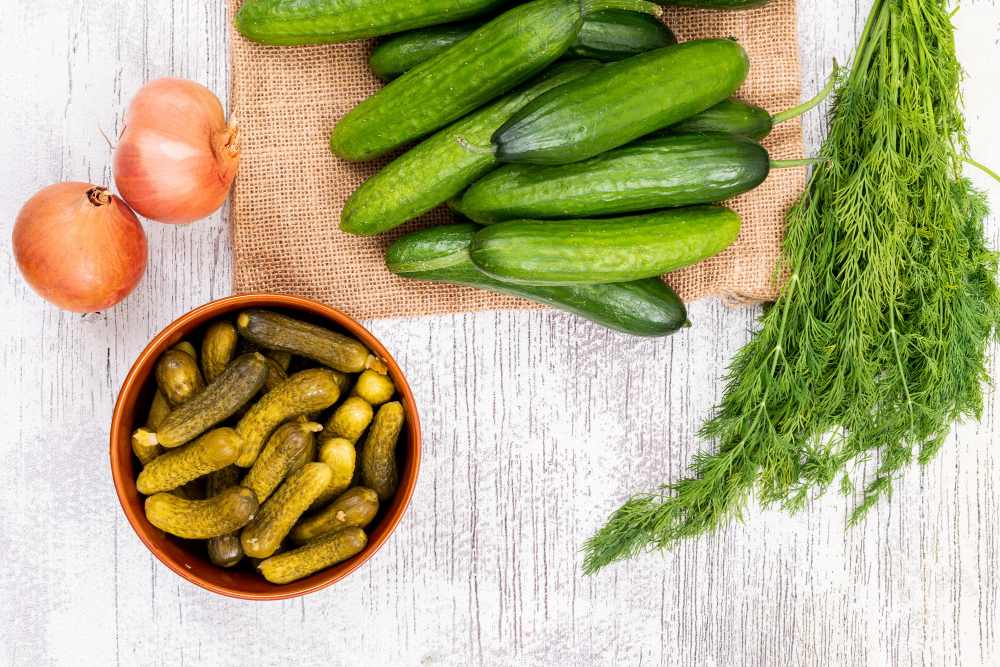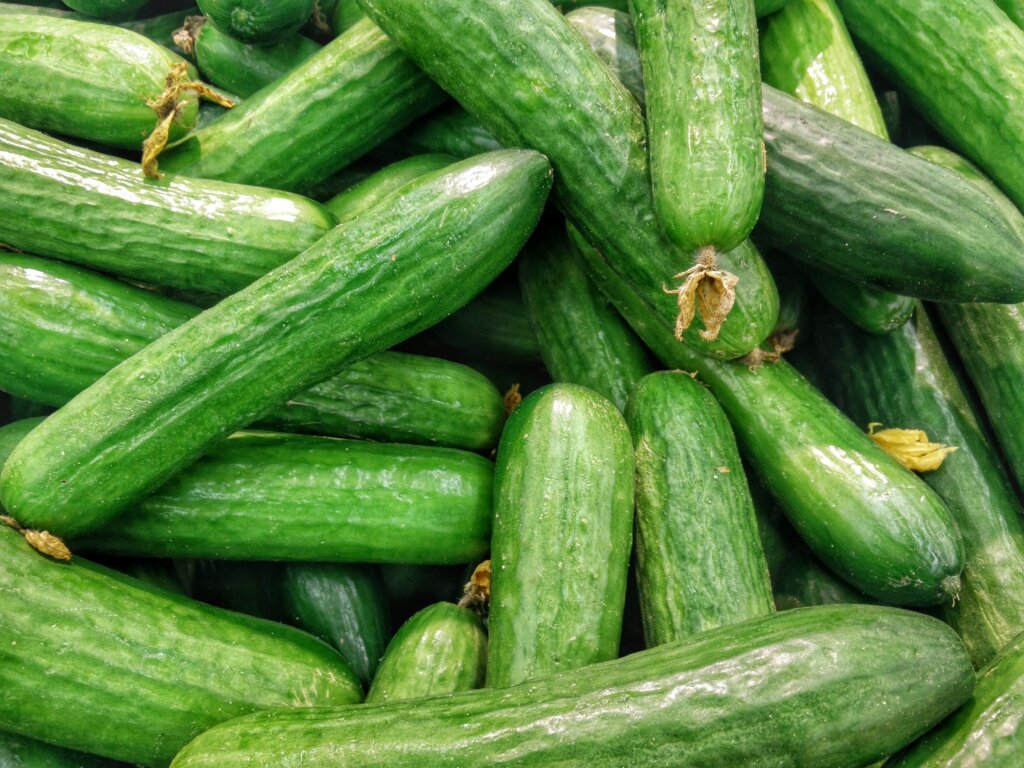Are you a cucumber lover? Do you know what cucumbers are, their types, and how they are classified? Here, in this blog, you can find out what cucumber is and its types.
What Are Cucumbers?
The cucumber is a famous, long, lean, and green garden fruit with the scientific name Cucumus sativus, belonging to the family Cucurbitaceae.
Botanically, they’re fruits because they’re grown from flowers ( fruits allow the flowering plant to reproduce). The cucumber has a large number of seeds that can be used to grow cucumber plants in the future. They also belong to the same family as watermelons and pumpkins, but most consider them vegetables.
They originated from various parts of Southeast Asia, but they are currently grown worldwide.
Depending upon the variety, there is variation in size and colour. Commonly, they are long and cylindrical and bright green.
What are the nutritional facts of cucumber?
95% of a cucumber is water.
Half cup of sliced cucumber (52g) with the peel contains about 95% water.
- Calories: 8
- Fat: 0.1g
- Sodium: 1mg
- Carbohydrates: 1.9g
- Fibre: 0.3g
- Sugars: 0.9g
- Protein: 0.3g
- Vitamin K: 8.5mcg
- Vitamin C: 1.5mg
- Potassium: 76.4mg
- Vitamin B5: 0.1mg
- Magnesium: 6.8mg
What are the different types of cucumbers?
1. Armenian Cucumbers
The Armenian cucumbers are long, thin, and curled in darker and lighter shades of light green or yellowish green. When they ripen (about 12 inches or 30 cm in length),) they become lighter and more yellow in appearance. They have burpless, smooth skin with pronounced ridges and pale green stripes. They are grown on vines and are also called snake cucumbers. They are delightfully crunchy and are very delicious when they are sliced and eaten raw. Their skin is fragile and has very soft seeds. They also do not require seeding or peeling before eating and are unsuitable for pickling.
2 American (Garden) Cucumbers
Garden cucumbers are burpless, short plum types most common in North America, with relatively smooth, thick skin and dark green. Their skin will be waxed while sold in shops to keep them fresh. They contain big seeds, hence must be deseeded before using them. They have a bitter taste. They will be perfect for any recipe once the seeds are removed. They can be eaten fresh in leaf salads, sandwiches, and pickled or grilled.
3. Gherkins
They are an unusual type of small cucumber with spiky skin, such as Cucumis anuria and crunchy texture. Mexican sour gherkin, which is also called cucamelon has smooth skin. They are oval-shaped and have only about 1.5 inches or 4 cm in length, having a strong taste that can be pretty sour. Gherkins is a term commonly used in English-speaking countries for pickled cucumbers. In some countries, it refers to a small or baby cucumber that has been pickled.
4. Mexican Sour Gherkins
They are the tiniest species in the Cucurbitaceae family of small grape-sized fruit. They are related to cucumbers but not to the genus Cucumis. They are also known as cucamelon, mouse melon or Mexican sour cucumber.
On first look, they resemble tiny watermelons but taste like cucumbers. They can be eaten fresh, straight off the vine or chop them to add to salads in the place of cucumbers.
They are great for pickling as they remain firm and require very little preparation. They are tiny, may not even be two inches long, and are prevalent in France. It is an excellent pickling choice as it easily fits inside the jar. Pickled gherkins are known as cornichons.
5. Kirby Cucumbers
Great pickling cucumber, having tough, bumpy skin that remains crunchy in the pickling liquid. The toughness of their skin can be retained in brine or pickling vinegar. They are of short length and will fit into the jar without having to cut them in half. Their skin ranges from yellow to dark green. They are crunchy when eaten raw. They are lovely when eaten raw. They should be flavoured while pickling.
6. Persian Cucumbers
They are small in size, have smooth skin, and contain very few seeds. As they don’t contain seeds and bump on the skin, it doesn’t mean they are bitter. They are known as a burpless cucumbers as they don,t have bumpy skin. They are one of the most popular types of cucumber that are consumed due to their fresh taste. They are great for slicing. Persian cucumbers have firm, crunchy flesh that is great for salads or cutting into spears to eat with a dip. These small study cucumbers hold up well when used for pickling or stir-frying.
These cucumbers are slightly shorter than English cucumbers, but, more or less, it has the same features as English cucumbers. The difference is that Persian cucumbers have greater length, whereas some are shorter, some are longer, and sometimes they have slightly bumpy skin as Kirby.
They have a mild flavour and thin skins, making them best for salads or as slices to scoop up the dip.
7. Lemon Cucumbers
As the name suggests, this cucumber looks similar to Lemons, has yellowish skin, and is sweet to taste. They do not have a bitter taste. They have thing skins, minimal soft seeds and are flavourful. This cucumber is quite popular across the globe, looking positive in different salads and making delicious pickles.
8. Japanese Cucumbers
Japanese cucumbers are also known as “kyuri” in Japanese. They are the best climbing cucumbers that produce narrow, sweet fruits. These cucumbers are dark green and slender with thin skin. They have very few seeds init, with slightly bumpy skin. They retain their sweetness even though they grew about 2 ft or 60 cm in length. The taste of Japanese cucumber is sweet and gives a crunchy feeling when you eat it.
9. English or seedless or hot-house cucumbers
They are burpless cucumber which is long and thin, with dark green shiny skin. Compared to other varieties, they are sweet, containing tiny seeds that prevent the light, crunchy flesh from tasting bitter.
They grow much longer and reach between 30 to 60 cm in length. It is about double the length of a fully ripened Persian cucumber. The ridges running the size of the skin of a Persian cucumber make it different from the English cucumber.
They are most preferred to eat raw and sliced up in sandwiches. They are similar to Telegraph Cucumbers, seedless, with great flavour and a thin edible green skin. They grow well in the greenhouse or outdoors.
10. Lebanese Cucumbers
They are another burpless cucumber plant with thin green skin and a sweet taste.
They are also similar to English cucumbers and are of the seedless variety. As opposed to English cucumbers, they are shorter. Lebanese cucumbers are a good option for slicing and pickling because they are crunchy and tasty.
11. Korean Cucumbers
They originate from Asia and have a crunchy, sweet taste. Their sweet flavour is delicious in salads or cut into fingers to eat raw. Their skin has no bitterness or slight bumps. Once pickled, they will retain their crunchiness and taste. Cucumber slices can be pickled by lightly sautéing them with sesame seeds after sprinkling them with sea salt to draw out the water.
12. Bush Champion Cucumber
They are an easy-to-grow bush variety of cucumber, specially developed to produce a good yield of sliced cucumber in a small space. They can be grown in containers or small vegetable patches. They have dark green skin that covers the burpless surface and has a crisp, mild flavour. They can be developed between 8 and 12 inches( 20 to 30 cm) in length and have a plum-like appearance.
13. Iznik Cucumbers
They are little cucumbers with thin skin. The seeds will have a crispy crunch when you bite into them. The sneak cucumbers grow on vines. They are 3 to 4 inches long and are the perfect lunch box cucumber. They can be grown in a greenhouse or can be grown as climbers.
14. Salt and pepper cucumbers
The Salt and Pepper cucumbers got their name from the white and dark spines on their spines on pale yellow skin. They don’t have green skin, unlike other vegetables. They have a fresh and crisp taste. The flesh of these cucumbers is greenish-yellow with very few seeds. It is a good slicer, pickles well, and is a colourful addition to any food.
They can be added to fresh salads as diced or sliced to give some colour and crunch.
15. Northern Pickling Cucumber

They are grown chiefly for pickling. The Northern Pickling cucumbers are short stout cucumbers which are vine cucumbers but not as sprawling as some other types of vine cucumbers.
They have yellowish-green bumpy skin with yellow stripes running the fruit length. It has firm flesh and skin, meaning it can retain its crunch after pickling. If you live in cooler climates with a short growing season, the northern pickling cucumbers are the best to grow. They are delicious cucumbers if you want to peel them and eat them fresh.
16. Tyria Cucumbers

The tyria cucumbers are a long green variety of seedless cucumbers that are perfect slicer with sweet, non-bitter flesh. They are vine-growing cucumbers that can grow upto 14 inches (35cm) in length. They have dark green skin with light ribbons down the length. They can be grown well in greenhouses and climbing up trellises.
Read More:
Sebum Plugs; Are They a Matter of Concern? How to Get Rid of It?
How to Remove Face Tan Naturally?
Healthy Homemade Tomato Face Mask for Acne
How to Lighten Dark Lips Permanently? Do You Know These 5 Methods?
7 Best Keratin Treatment Products in India That Are Formaldehyde-Free
Final Word
Cucumbers are a great energy source, constituting 95% water and offering a wide range of nutritional benefits. Various cucumbers are used for different purposes like salads, pickling etc. They can be eaten raw or fresh, having a pleasant taste. Hope this blog finds useful to you. Your suggestions and comments are always valuable.

